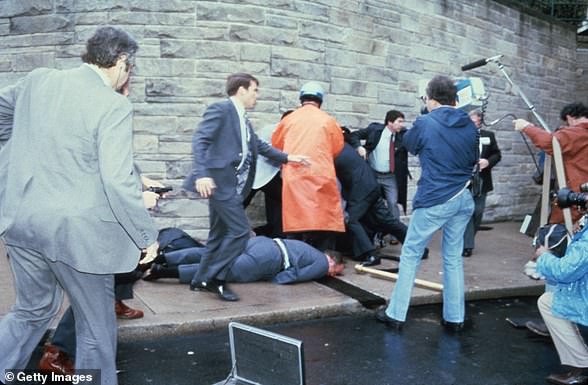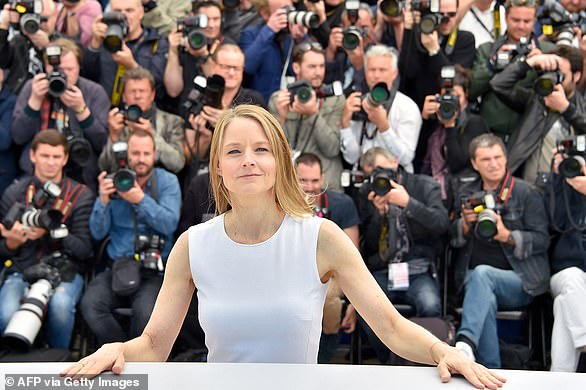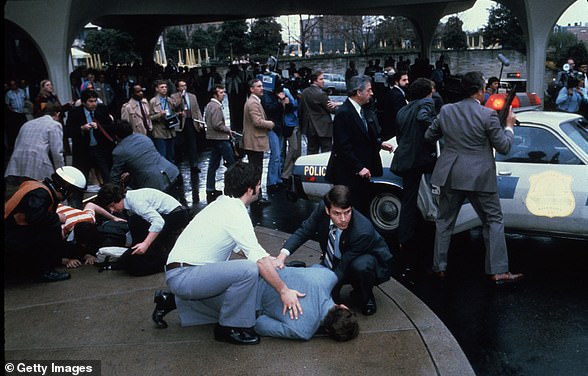Drifter John Hinckley Jr., 68, who tried to assassinate Ronald Reagan in 1981 and left then-president badly-wounded moans he’s a victim of cancel culture after venues refused to host his music concerts
Ronald Reagan was shot outside the Washington Hilton Hotel on March 30, 1981, after giving a speech at an AFL-CIO meeting.
Shooter John Hinckley Jr. fired a .22 Long Rifle round that ricocheted off the presidential limousine and hit Reagan in the torso, puncturing a lung and causing severe internal bleeding.
Hinckley fired six shots as Reagan left the hotel. James Brady, the White House press secretary; Timothy McCarthy, a Secret Service agent; and Thomas Delahanty, a police officer, were also injured.
Ronald Reagan was seriously injured on March 30, 1981, when Hinckley tried to kill him

Chaos Surrounds the Shooting of Victims Immediately After the Assassination of President Reagan, March 30, 1981, by John Hinckley Jr. outside the Hilton Hotel in DC

The assassination attempt was a desperate and misguided attempt by Hinckley to impress actress Jodie Foster
Hinckley was desperate to impress actress Jodie Foster after seeing her in the 1976 film Taxi Driver.
Hinckley came from a wealthy family. His father Jack Hinckley, who died in 2008, was chairman and president of the Vanderbilt Energy Corporation.
He moved to LA to become a songwriter and wrote letters to his parents telling how he had found love with a woman named Lynn Collins – who turned out to be a figment of his imagination.
After Foster enrolled at Yale in 1980, Hinckley moved to New Haven, Connecticut. He signed up for writing classes to be near her, and slipped notes under her dorm door.
When she didn’t answer, he decided on a grand gesture: either commit suicide in her presence, hijack a plane, or kill the president.
He decided on the latter and began to see how he could get close enough to Jimmy Carter to carry out his deadly attack.
He followed the Democrat around the country and was arrested on gun charges in Nashville, but he never got a chance to take action.
By the time he had a plan, Carter was already out of the White House and Republican Reagan was there.
Shortly before he shot the president, he sent Foster a note.
It read: ‘Over the past seven months I have left you dozens of poems, letters and messages of love in the vague hope that you might develop an interest in me.
‘Although we’ve spoken on the phone a few times, I’ve never had the courage to simply approach you and introduce myself. The reason I’m going ahead with this attempt now is because I can’t wait any longer to impress you. —John Hinckley Jr.”

Injured in the attempted assassination of Reagan were press secretary James Brady and agent Timothy McCarthy. The aftermath of the shooting can be seen above
Reagan was rushed to George Washington University Hospital, just over a mile away, and was routinely screened by the Secret Service as a possible emergency treatment location for the president.
Walter Reed National Military Medical Center, where presidents routinely receive medical care, is about ten miles from downtown DC.
Reagan underwent emergency surgery.
Despite the severity of his injuries, Reagan was eager to show that he was on the mend. He met with visitors and signed a piece of legislation the morning after the shooting.
He remained at GWU Hospital for twelve days and returned to the White House on April 11, 1981.
Lawyers for Hinckley argued that he was “no longer a threat” and that he should not be held to a series of court-ordered restrictions put in place after he was released from a 35-year stint in a Washington psychiatric hospital. 2016.
Hinckley was allowed to move with his elderly mother to a gated community in Virginia, while adhering to a series of court-ordered stipulations and under the constant supervision of doctors and therapists.
In 2022 he became a completely free man.
